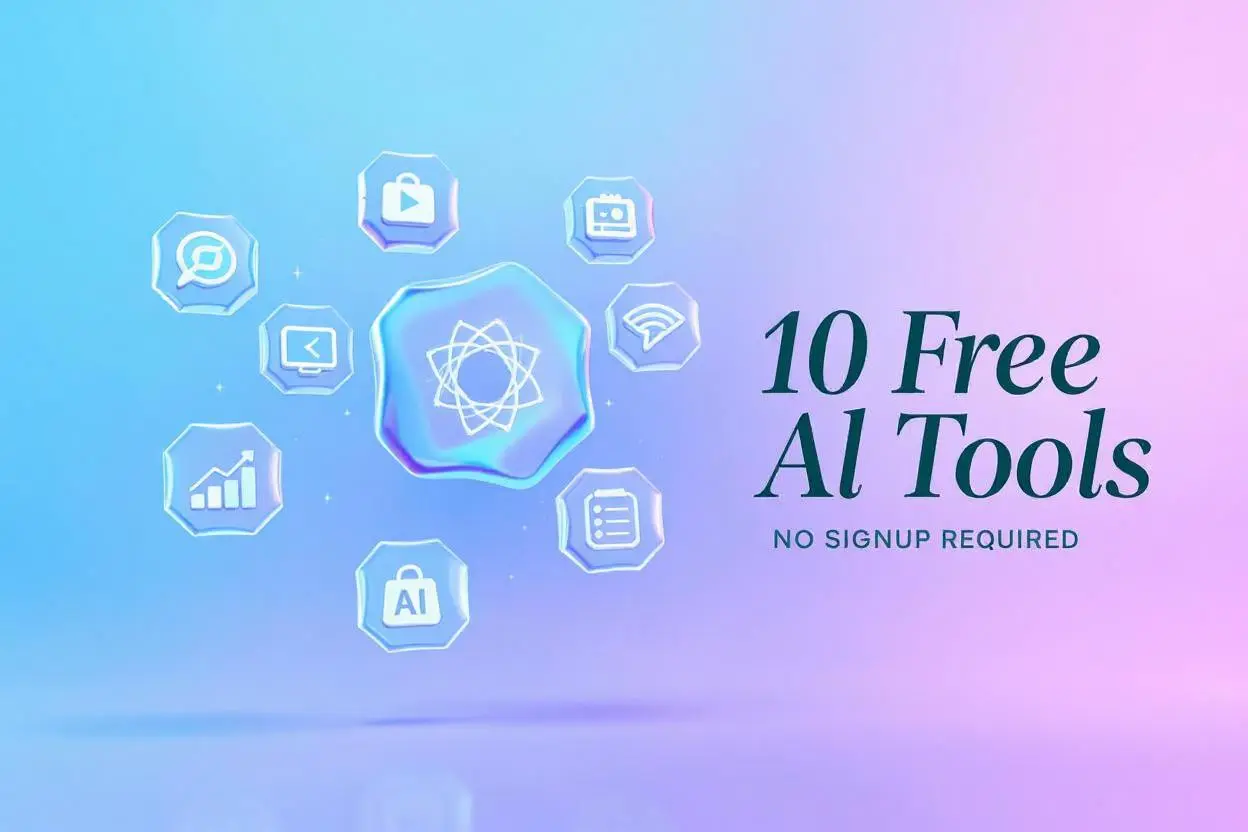
Why Free AI Tools Without Signup Matter in 2025
You know what's frustrating? Finding the perfect AI tool only to hit that dreaded signup wall. Email address, password creation, email verification – sometimes it feels like you need to write your life story just to try a simple AI feature. That's exactly why I've become obsessed with finding free AI tools that require no signup whatsoever.
In 2025, the AI landscape has exploded with options, but many tools have gotten increasingly aggressive about collecting user data. However, there's still a goldmine of powerful AI tools that you can access instantly – no email required, no passwords to remember, and definitely no spam in your inbox later.
I've spent countless hours testing these tools (honestly, my browser history looks like I'm researching for NASA), and I can tell you that some of the best AI experiences happen when there's zero friction between you and the tool. Whether you're a content creator on deadline, a student working on a project, or just someone curious about AI capabilities, these no-signup tools can be absolute lifesavers.
The beauty of instant-access AI tools isn't just convenience – it's about democratizing technology. When there are no barriers to entry, anyone can experiment, learn, and create. Plus, let's be honest, sometimes you just want to test something quickly without committing to another account you'll forget about in a week.
Complete List of 10 Free AI Tools (No Registration Required)
After testing dozens of tools across multiple categories, I've compiled this verified list of 10 AI tools that work immediately without any signup requirements. Each tool has been personally tested as of July 2025, and I've organized them by category to help you find exactly what you need.
TinyWow (tinywow.com)
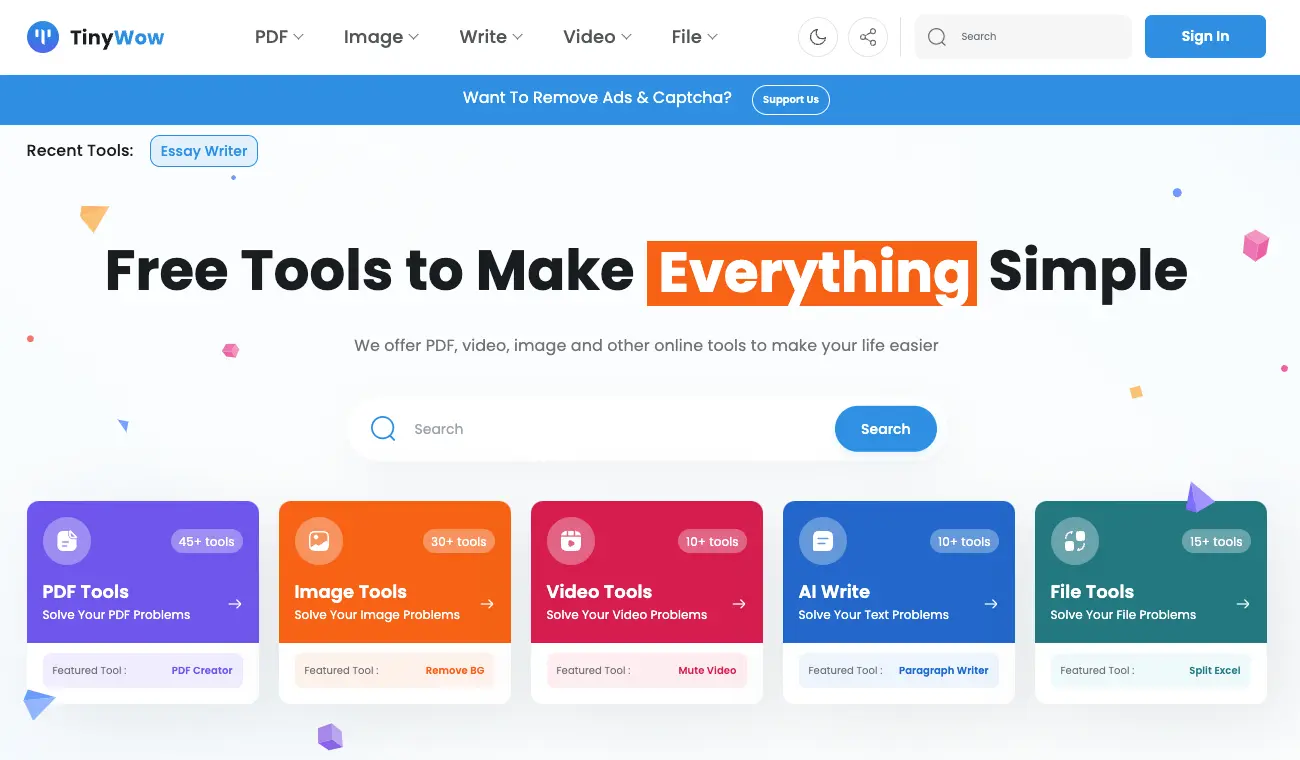
This is honestly one of my favorite discoveries, and I keep coming back to it almost daily. TinyWow isn't just one tool – it's like a Swiss Army knife of AI utilities with over 200 different tools spanning writing, PDF editing, image manipulation, legal document generation, and even random stuff like QR code creators.
The writing section alone has saved me countless hours. Their text summarizer is fantastic for condensing those brutal 20-page research papers into digestible bullet points. I remember using it last month to summarize a competitor analysis report that was putting me to sleep – turned 15 pages into 5 key takeaways in about 30 seconds. Their grammar checker catches stuff that even my careful proofreading misses, and the paragraph rewriter is clutch when I need to rephrase content for different audiences without changing the meaning.
But here's what really sets TinyWow apart: it's completely ad-free. No annoying pop-ups, no banner ads interrupting your workflow, no "upgrade now" messages every two seconds. Just pure, clean functionality. This is incredibly rare among free tools and makes such a difference when you're trying to focus.
I've also used their PDF tools extensively – merging documents for client presentations, extracting text from scanned files (works surprisingly well), and even their legal template generator when I needed a basic freelance contract outline. The legal stuff isn't lawyer-quality, but it's perfect for simple agreements.
The only real downside is peak hours. Usually between 10am-2pm EST, processing slows down from instant to about 30-60 seconds. Still totally usable, just not as zippy. But honestly, for completely free access to this many tools without ads? I'm not complaining.
ToolBaz AI Text Generator (toolbaz.com)

ToolBaz is solid for content ideation, especially when I'm stuck on article structure. Their blog outline generator helped me brainstorm angles for a client's newsletter that I never would've considered. You can choose between different AI models (GPT-3.5, GPT-4, Claude), which is nice for experimenting.
The main limitation is the daily cap – around 10-15 generations per day. Usually enough for my needs, but you need to be strategic about it.
Picsart AI Writer (tools.picsart.com)
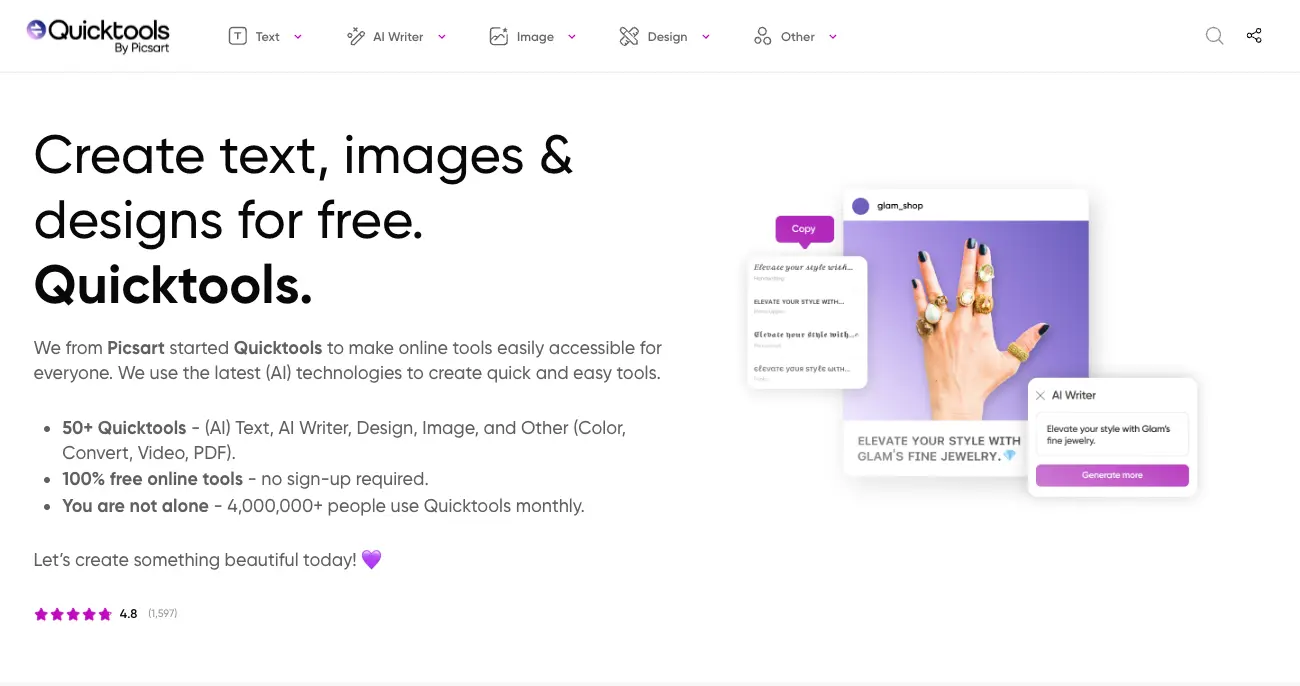
Don't be fooled by the name – Picsart's writing tools are actually pretty decent. Their caption generator consistently produces engaging copy that doesn't sound robotic, which is harder to find than you'd think. I've used it for LinkedIn posts and Instagram captions with good results.
The text-to-speech feature is handy for testing how content sounds when read aloud – helps catch awkward phrasing that looks fine but sounds weird. The tools are a bit buried in their interface, but once you find them, they're straightforward.
SEMrush Free AI Text Generator
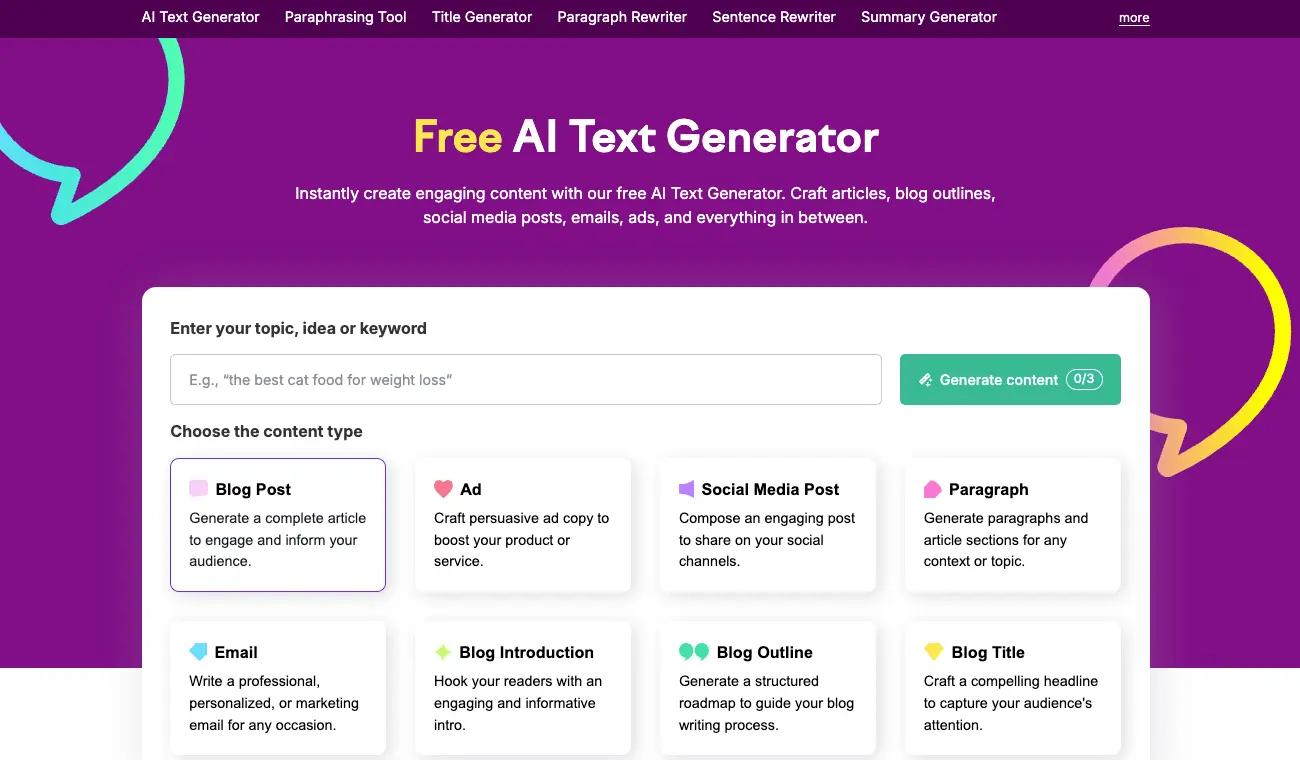
Only 3 uses per day, but the quality is consistently high for SEO-focused copy. Their meta descriptions actually convert – they understand character limits and create compelling copy that gets clicks. I save my daily uses for high-stakes stuff like email subject lines where quality really matters.
AI Humanizer Tools (Multiple Providers)
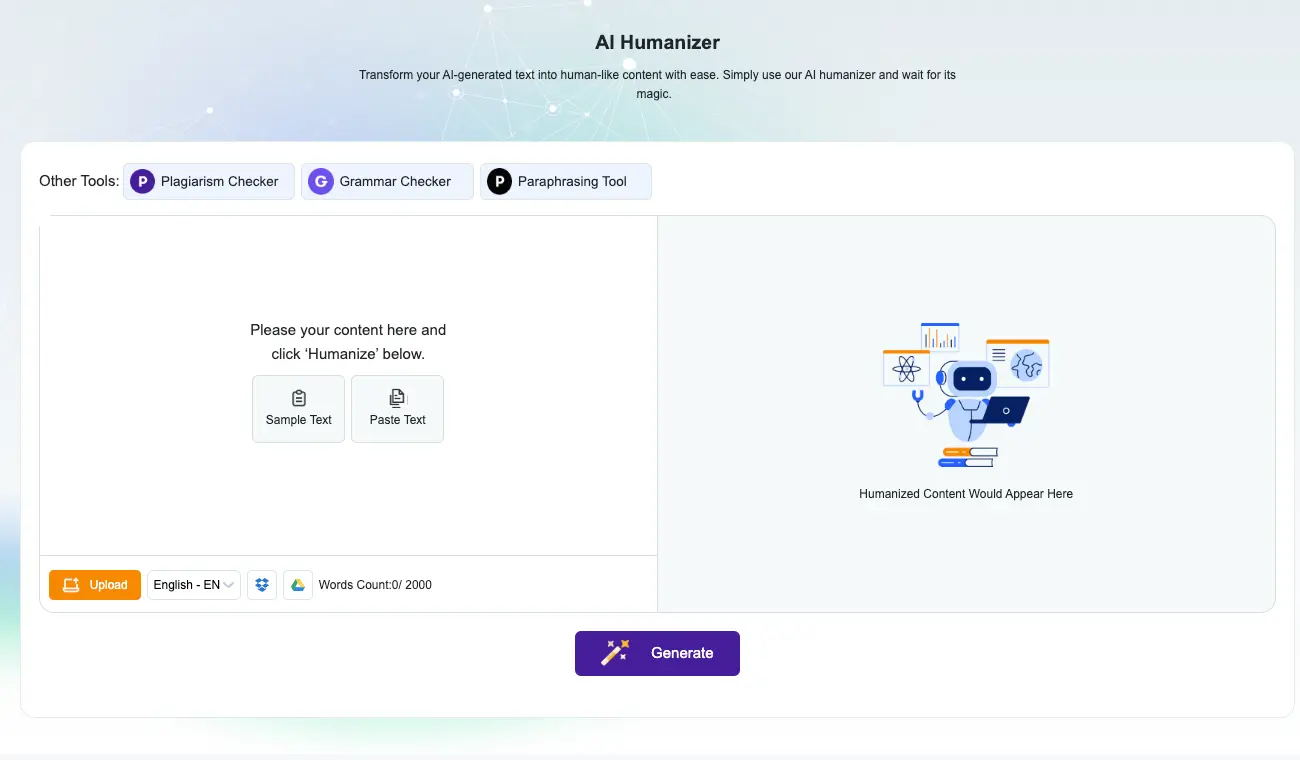
Look, I know it's ironic using AI to make AI content seem less AI-like, but these tools are genuinely useful. SmallSEOTools is the most reliable – it varies sentence structure and adds natural transitions without losing meaning. NoteGPT maintains technical accuracy while improving readability, and Writecream adds more personality.
I use these as part of a workflow: generate content, humanize it, then polish with grammar tools. The combination often produces content that's both high-quality and naturally readable.
Grammarly AI Humanizer

Grammarly's approach is more conservative than other humanizers – it makes targeted improvements rather than rewriting everything. Good for business content where you need to maintain professionalism while improving engagement. Works best with longer passages.
If you find yourself regularly needing more advanced writing assistance, explore Grammarly's full suite of professional features which includes advanced grammar checking, tone detection, and team collaboration tools that go well beyond their free humanizer.
Magic Eraser Tools (Multiple Providers)
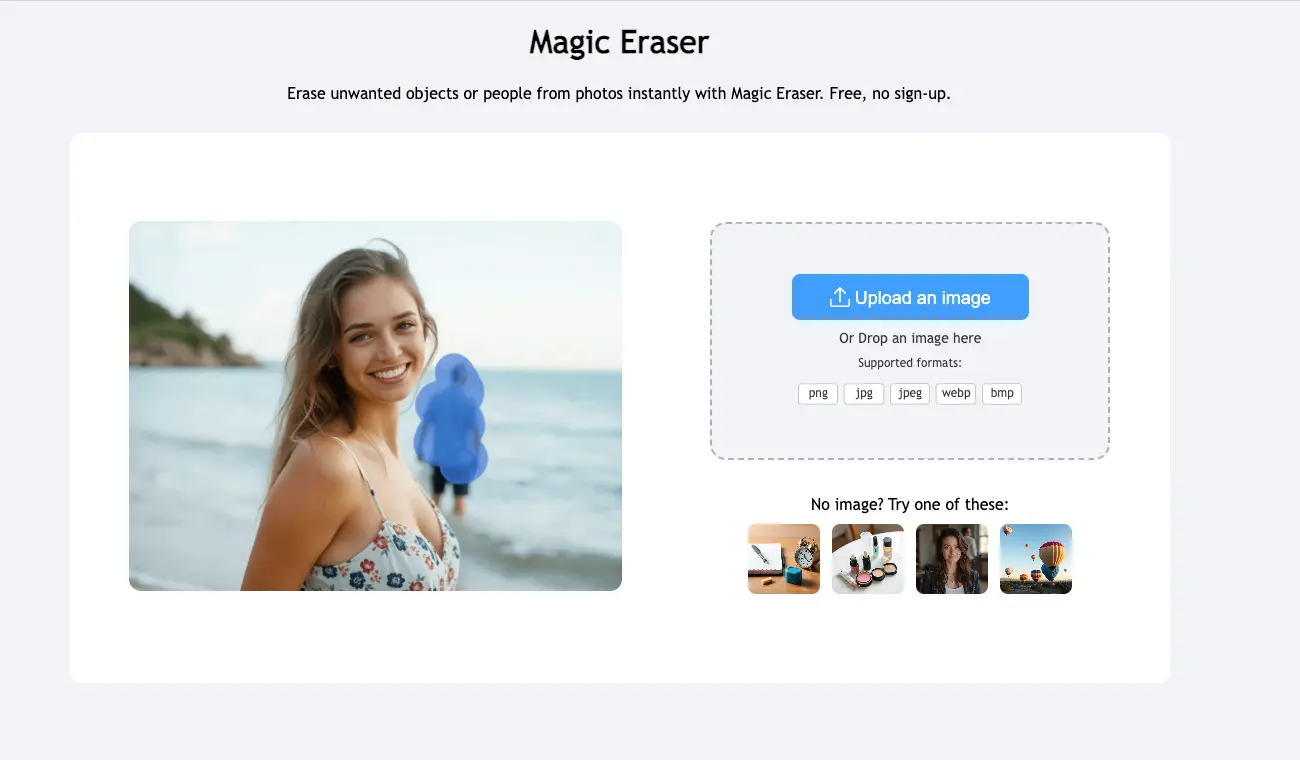
I've probably spent more time testing these than I should admit. Remaker.ai produces the cleanest results for simple removals – great for eliminating people from backgrounds or removing power lines from landscape photos. Their edge detection and shadow consistency is impressive.
Magicstudio.com handles complex scenarios better. I used it to remove tourists from architectural photos for a travel blog client, and it worked way better than I expected. Magiceraser.org is the speed demon – usually under 10 seconds, perfect for quick social media fixes.
Success rate is probably 70% perfect, 20% usable with minor touch-ups, 10% "well, that didn't work." For free tools, those are pretty good odds. I've used them for everything from cleaning up product photos to removing "For Sale" signs from real estate shots.
Venngage AI Tools (venngage.com/ai-tools)
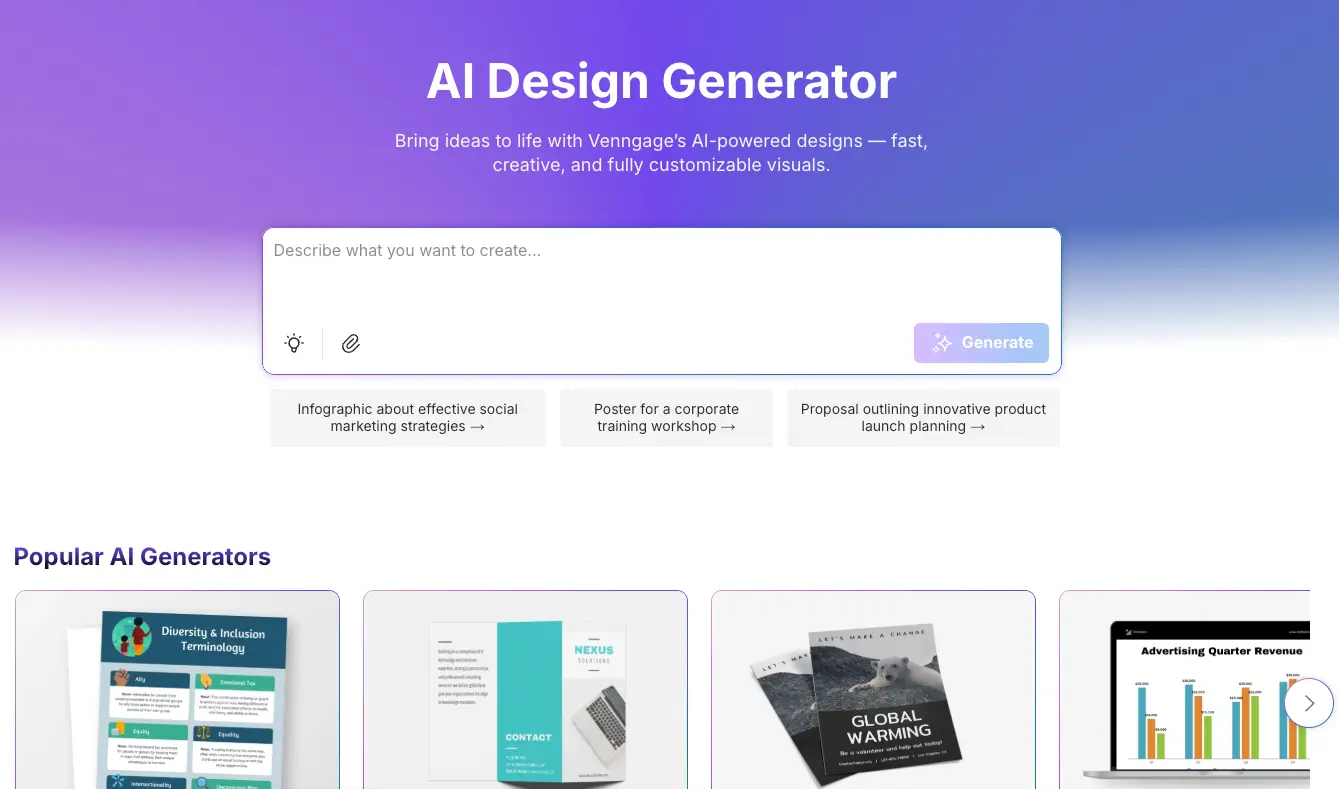
Decent for quick infographics when you need professional-looking visuals without the learning curve of complex design software. The AI suggests appropriate chart types based on your data, which is helpful when you're not sure how to visualize something. Templates look modern enough for business presentations.
Limited compared to their premium version, but covers basic visualization needs. For users who need more advanced graphic design capabilities beyond basic infographics, explore our comprehensive guide to premium visual design AI tools that offer advanced features like custom branding, animation, and professional templates.
Animated Drawings by Meta (sketch.metademolab.com)
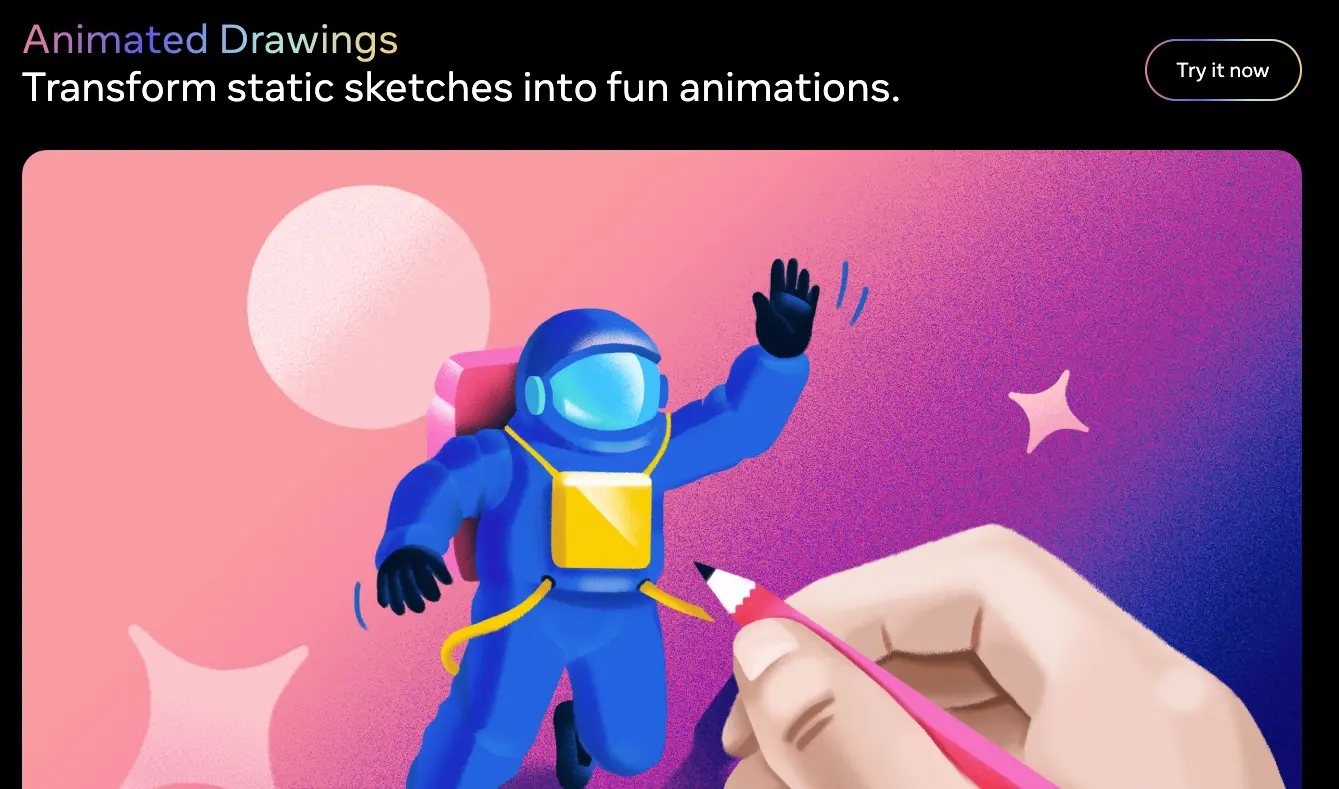
This tool is absolutely magical and never fails to impress people. Upload any drawing – I'm talking stick figures, detailed sketches, even napkin doodles – and Meta's AI brings it to life with realistic animations. The joint detection technology is genuinely impressive; it recognizes body parts in even the crudest drawings and applies natural movement patterns.
I've used it for presentations to break tension (nothing like an animated stick figure demonstrating a process flow), entertained my nephew for hours (his superhero drawings coming to life blew his mind), and even brought old college sketches to life just for fun.
Processing takes 30 seconds to 2 minutes depending on complexity and server load. Sometimes fails with very detailed drawings, but when it works, the animations are smooth enough for professional use if your brand allows for some playfulness.
Documator (documator.cc)
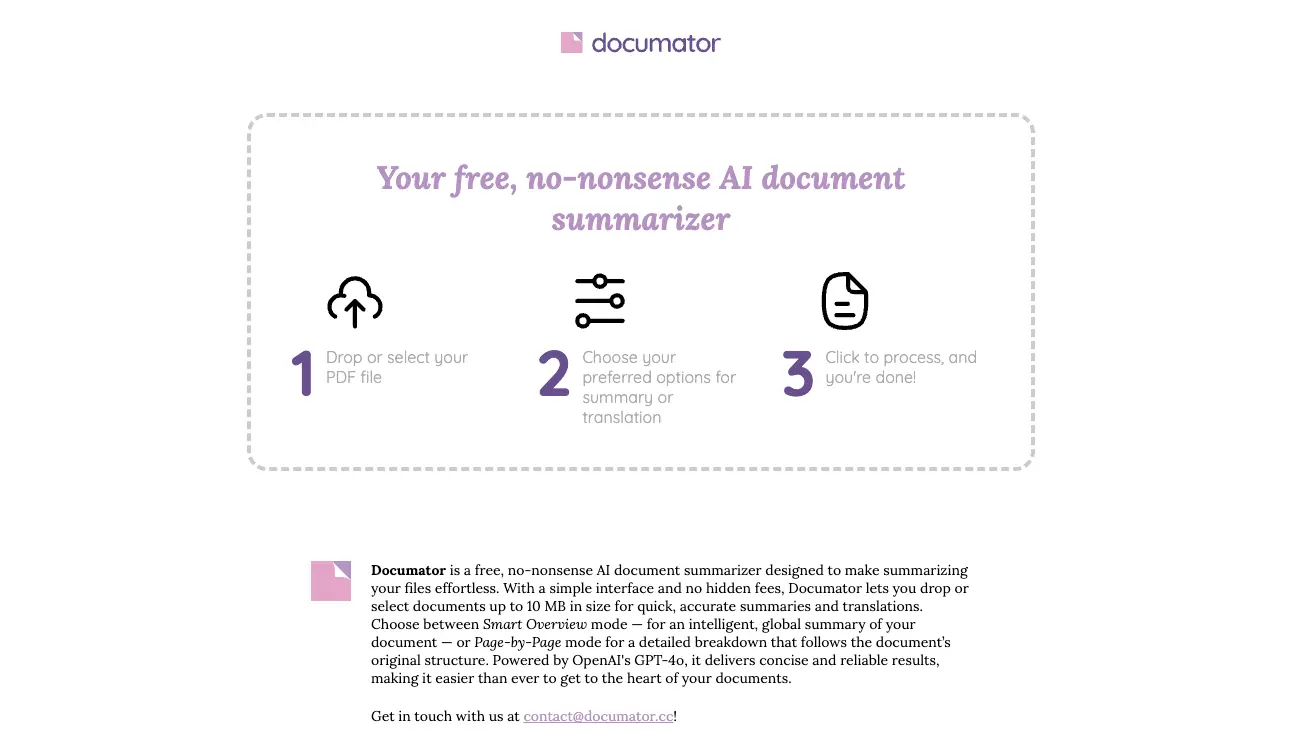
My go-to for PDF summarization when I need to quickly digest lengthy documents. Two modes: Smart Overview gives you a global summary of the entire document, while Page-by-Page provides detailed breakdowns following the original structure.
I've used it for everything from academic papers to legal contracts to technical manuals. Great for literature reviews when you need to understand how arguments build, or for identifying key terms in contracts without reading every clause. Handles documents up to 10MB, though very large files (50+ pages) sometimes get truncated summaries.
Processing time varies from 30 seconds for short docs to a few minutes for longer ones, but the quality is solid – captures main points without losing crucial context.
How to Choose the Right No-Signup AI Tool
After testing all these tools, I've developed a mental framework for choosing the right one for each task. Here's what I consider:
Speed vs. Quality Trade-off
Free tools without signup requirements often prioritize speed over perfection. TinyWow, for example, processes requests quickly but might not match the nuanced output of premium alternatives. That's perfectly fine for most use cases – you just need to set appropriate expectations.
Task Complexity
Simple tasks like basic image editing or quick text generation work beautifully with no-signup tools. More complex projects requiring multiple iterations or advanced customization might push you toward tools that offer account-based features.
I've found that the sweet spot for no-signup tools is handling 80% of common tasks really well, rather than trying to be everything to everyone.
Reliability and Uptime
Some free tools experience higher traffic and slower response times during peak hours. I've noticed this particularly with image processing tools around lunch hours and evenings. If you're working on time-sensitive projects, factor in potential delays.
Output Limitations
Many no-signup tools have reasonable limitations – maybe you can process 5 images per hour or generate 3 pieces of content per day. I've never found these limits restrictive for normal use, but it's worth knowing upfront.
Privacy Considerations
While these tools don't require personal information, they still process your content. For sensitive documents or proprietary images, consider what data you're comfortable sharing. Most reputable no-signup tools clearly state their data handling practices.
Tips for Using Free AI Tools Effectively
Through trial and error (emphasis on error), I've learned some strategies that dramatically improve results with free AI tools:
Start with Clear, Specific Inputs
Vague inputs produce vague outputs. Instead of "write about marketing," try "write a 200-word paragraph explaining why email marketing still works in 2025." The difference in output quality is night and day.
Use Multiple Tools for Comparison
Since you're not locked into one platform, take advantage of variety. I often run the same request through 2-3 different text generators and pick the best elements from each result. It takes an extra few minutes but produces much better final content.
Keep Realistic Expectations
Free tools are incredibly powerful, but they're not magic. I've learned to view them as sophisticated starting points rather than final solutions. This mindset shift eliminated most of my frustration and made the tools much more useful.
Save and Document Good Prompts
When you find prompt wording that produces excellent results, save it. I keep a simple text file of effective prompts for different tools and situations. It saves tons of time and improves consistency.
Combine Tools Strategically
Some of my best results come from chaining tools together. For example, I might use ToolBaz to generate initial content, run it through an AI humanizer, then use TinyWow's grammar checker for final polish. The combination often produces results that rival premium services.
Time Your Usage
I've noticed that some tools perform better during off-peak hours. If you're getting slow responses or lower-quality outputs, try again later in the day or early morning.
Bookmark Your Favorites
This sounds obvious, but I can't tell you how many times I've forgotten the exact URL of a useful tool. Create a dedicated bookmark folder for your no-signup AI tools – you'll thank yourself later.
Future of No-Registration AI Tools
The landscape for free AI tools without signup requirements is evolving rapidly, and I'm cautiously optimistic about where it's heading.
Increasing Quality Standards
What excites me most is how tool quality keeps improving. Compare today's free image editors to what was available just two years ago – the difference is staggering. I expect this trend to continue as AI models become more efficient and competition intensifies.
Sustainability Challenges
However, there's a real question about long-term sustainability. Running AI tools costs money, and companies need revenue streams. I've already seen some previously free tools introduce signup requirements as they scale.
The tools that seem most likely to remain free and accessible are those with clear monetization strategies that don't depend on user data collection – perhaps through premium tiers or business partnerships.
Mobile-First Development
More no-signup tools are being designed mobile-first, which is fantastic for accessibility. I've noticed newer tools work seamlessly across devices without requiring app downloads or account syncing.
Specialized vs. General Purpose Tools
The trend seems to be moving toward specialized tools that excel at specific tasks rather than trying to be everything to everyone. TinyWow's success suggests there's still room for tool suites, but the best individual tools tend to focus deeply on particular use cases.
Privacy-First Approaches
Consumer awareness about data privacy is driving more companies to offer meaningful functionality without requiring personal information. This trend aligns perfectly with the no-signup model and could lead to more sustainable, privacy-focused AI tools.
Integration Possibilities
I'm seeing early experiments with browser extensions and API integrations that could make no-signup tools even more seamless to use. Imagine having your favorite AI tools available in any text field or image editor without leaving your current workflow.
The key for users is staying informed about new tools while being prepared for changes to existing ones. The AI landscape moves fast, and today's favorite free tool might require registration tomorrow – or might be replaced by something even better.
What gives me hope is that the fundamental demand for accessible, immediate AI assistance isn't going anywhere. As long as people need quick solutions without friction, there will be tools designed to meet that need. The specific tools may change, but the category seems here to stay.
Whether you're a casual user who occasionally needs AI assistance or someone who relies on these tools for regular creative work, the current selection of free AI tools without signup requirements offers remarkable capability and convenience. Just remember to stay flexible, keep exploring new options, and always have backup tools in your toolkit.
Frequently Asked Questions About Free AI Tools No Signup
Are these free AI tools really free forever?
Most of these tools operate on freemium models where basic features remain free while advanced features require payment. However, some tools have changed their policies over time. I recommend bookmarking multiple alternatives for each type of task so you're never stuck if one tool changes its requirements.
How do these companies make money if they don't require signups?
These companies typically monetize through premium upgrades, advertising, API usage by businesses, or by using the free tier as a marketing funnel for their paid services. Some are funded by larger companies (like Meta's Animated Drawings) as part of broader AI research initiatives.
Are no-signup AI tools safe to use with sensitive content?
While these tools don't require personal information, they still process your content on their servers. For sensitive documents, proprietary images, or confidential information, I'd recommend using downloadable AI tools or premium services with clear privacy guarantees.
What's the difference between AI-generated and AI-refined content?
AI-generated content is created entirely by artificial intelligence from a prompt. AI-refined content is human-written text that's been improved by AI tools (like grammar checkers or paraphrasers). Tools like the AI humanizer services can help make AI-generated content sound more natural.
Can I use these tools for commercial projects?
Most of these tools allow commercial use of their basic features, but you should check each tool's terms of service. Some may have restrictions on selling AI-generated content or using their output for certain types of businesses.
Why do some tools work better at certain times?
Free tools often experience higher traffic during business hours and peak internet usage times. Since they prioritize paying customers, free users may experience slower processing during busy periods. Early morning or late evening usage often yields faster results.
Which Magic Eraser tool should I use?
It depends on your specific needs: remaker.ai for simple object removal, magicstudio.com for complex backgrounds, and magiceraser.org for speed. I often try all three with the same image to see which produces the best result.
What should I do if a tool stops working or requires signup?
Keep a list of alternative tools for each category. The AI landscape changes rapidly, so having backup options is essential. Also, check if the tool offers a different access method (like through their main website vs. a direct tool link).
Can I combine outputs from multiple AI tools?
Absolutely! Some of my best results come from using multiple tools in sequence. For example, generating initial content with ToolBaz, refining it with an AI humanizer, then checking it with TinyWow's grammar tools. Just be mindful of any terms of service restrictions.
How do I know if a tool is legitimate and safe?
Look for tools from established companies, check for HTTPS encryption, read their privacy policies, and start with non-sensitive content to test reliability. Avoid tools that ask for unnecessary permissions or seem too good to be true.
The future of AI accessibility looks bright, and we're all better off when powerful technology is available to everyone – no barriers, no gatekeeping, just immediate access to tools that can enhance our creativity and productivity.
